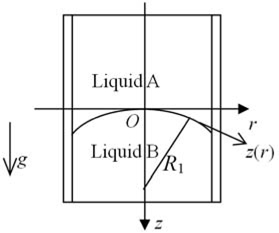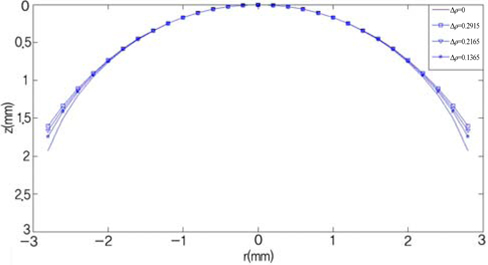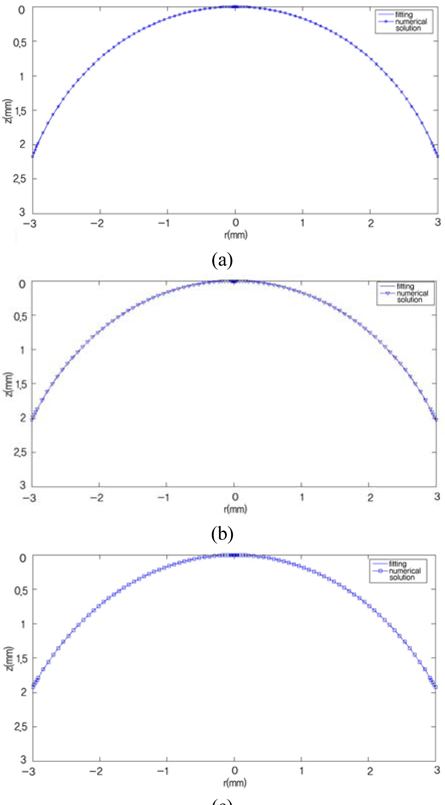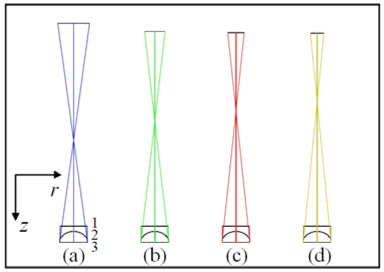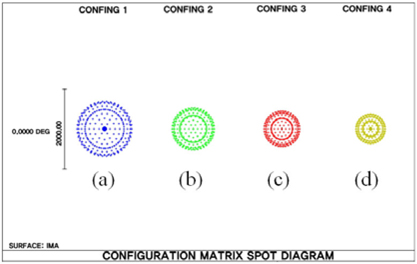



The effect of the liquid density difference on interface shape of a double-liquid lens is analyzed in detail. The expressions of interface shape of two liquids with liquid density difference are analyzed and fitted with “even asphere”. The imaging analysis of the aspheric interface shape of a double-liquid lens is presented. The results show that the density difference of two liquids can cause the interface to be an aspheric surface, which can improve the image quality of a double-liquid lens. The result provides a new selection for the related further research and a wider application field for liquid lenses.
The liquid lens is a novel optical element which features dynamic adjustment of the lens refractive index or its surface shape to change the focal length. The liquid lens has the advantage of being able to change focal length without mechanically moving the lens, which can provide considerable power savings and can eliminate wear associated with moving parts [1], so it is widely used in a large variety of application areas, such as mobile phones [2], surgical instruments [3], miniature cameras [4], and so on. The double-liquid lens [4-7] based on the electrowetting effect is highly regarded because of its outstanding performance [7].
Currently in most of the studies about the double-liquid lens, the two liquids’ densities are the same to ensure that the liquid interface is a spherical surface [8, 9]. The density difference of two liquids can affect the interface shape and the final focal length of the system [10]. In this paper, the effect of the two liquids’ density difference on the interface shape is discussed in detail, and the imaging quality of the double-liquid lens with an aspheric interface is analyzed with Zemax optical design software.
II. ANALYSIS AND FITTING OF INTERFACE SHAPE OF DOUBLE-LIQUID LENS
Figure 1 is the schematic diagram of a double-liquid lens. According to the Laplace equation [11], at any point on the interface of two liquids,
where Δ
In accordance with the coordinate system of Zemax software, here choose the coordinate system shown in Fig. 1; the origin of the coordinate is at the interface apex, the
where
The pressures at each point of the interface can be expressed as
where
where Δ
Combine Eqs. (1)~(3), (6) and (7), and a differential equation, which determines the shape of the liquid interface, can be obtained:
Eq. (8) is the relationship between the liquid density difference and the interface shape of a double-liquid lens. The interface shape is completely spherical when the density difference of the two liquids is zero [7].
In order to analyze the effect of the two liquids’ density difference on the interface shape in detail, two liquids with different densities are chosen, for example, CH2Cl2 as “Liquid A” (insulating liquid, the density
[TABLE 1.] The density of NaCl solution with different concentration, Δρ

The density of NaCl solution with different concentration, Δρ
By using these values of Δ
The aspheric interface shapes of double-liquid lenses are fitted with a rotationally symmetric polynomial aspheric surface (even asphere), which in Zemax is given by
where
[TABLE 2.] The aspheric coefficients αi with different liquid density differences

The aspheric coefficients αi with different liquid density differences
III. IMAGING ANALYSIS OF THE INTERFACE SHAPE
With the aspheric coefficients shown in Table 2, the double-liquid lenses with aspheric interface are designed with Zemax. For comparison, the double-liquid lens with spherical interface is designed, too.
The schematic plots of double-liquid lenses with (a) Δ
Due to the gravity effect, in the section of imaging analysis with Zemax, the pupil diameter of the double-liquid lens is limited to be 5 mm [9]. When the diameter of the double-liquid lens is greater than 5 mm, the gravity effect needs to be considered. In this paper, the work is mainly focused on the discussion of the stable static interface shape of double-liquid lens; the analysis of interface shape is completed without consideration of liquid internal pressure changes and under no applied voltage on the conducting liquid. The effect of internal pressure and external applied voltage on the interface shape of the double-liquid lens will be analyzed in our further research.
On the other hand, in order to ensure the symmetry, the price of obtaining a stable aspheric interface in the double-liquid lens is that it is necessary to fix the position of the lens and not to move it at will. In the future, the liquid lens with aspheric interface will be used in the human eye model, as a confirmed zooming system, which can be applied to provide the intuitive presentation of human eye zooming characteristics. We are conducting the research work of the human eye model containing a liquid lens. The liquid lens with aspheric interface may be applied in the other fixed presentation models like the human eye system.
The development of the aspheric lens is limited by manufacturing costs. However, by the above analysis and fitting of interface shape of the double-liquid lens, it is found that the aspheric surface of the double-liquid lens can be obtained by the liquid density difference easily. And the image quality of the double-liquid lens with aspheric interface is improved obviously. Therefore, the result provides a new selection for the related further research and a wider application field for the liquid lens.
